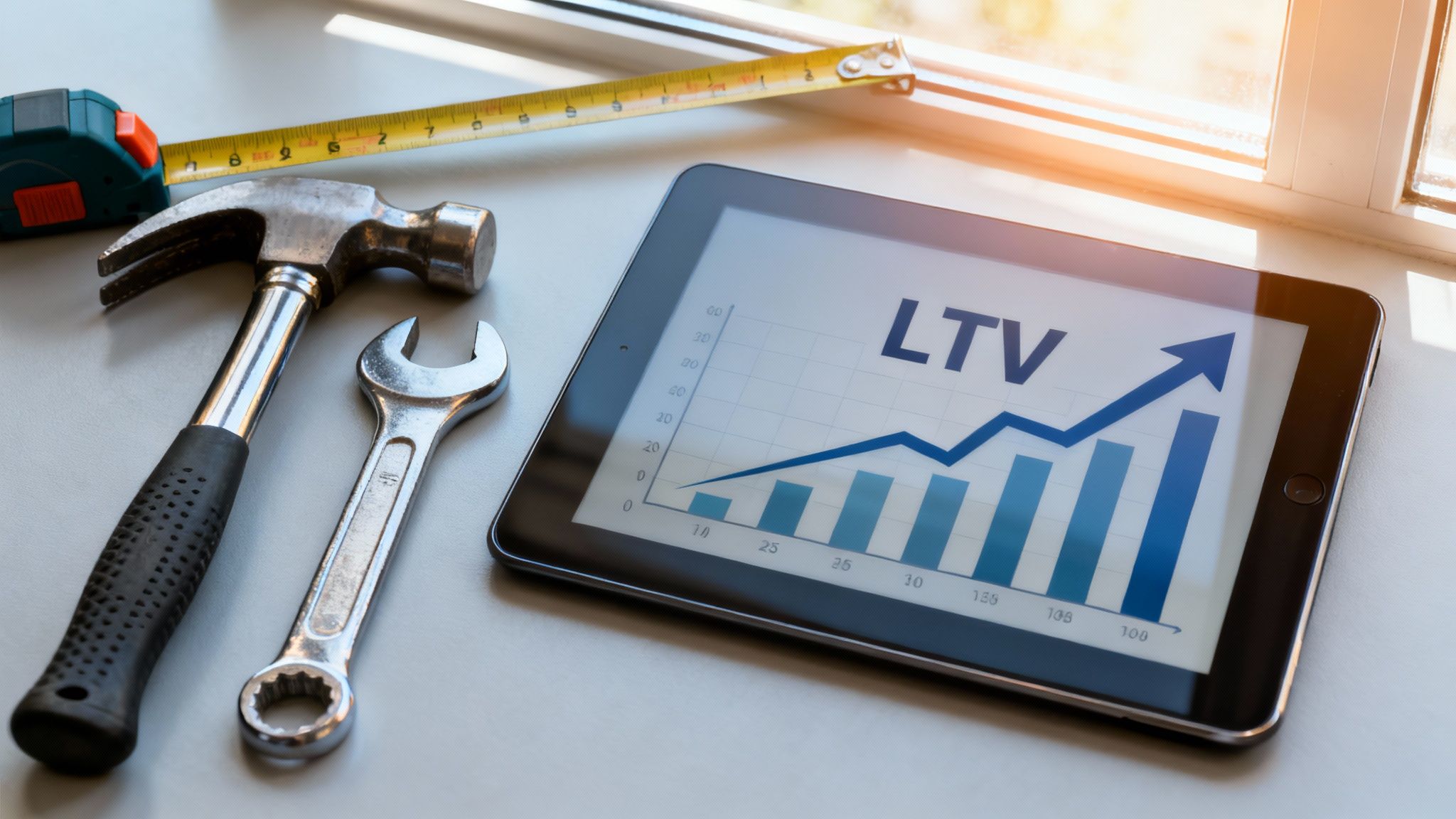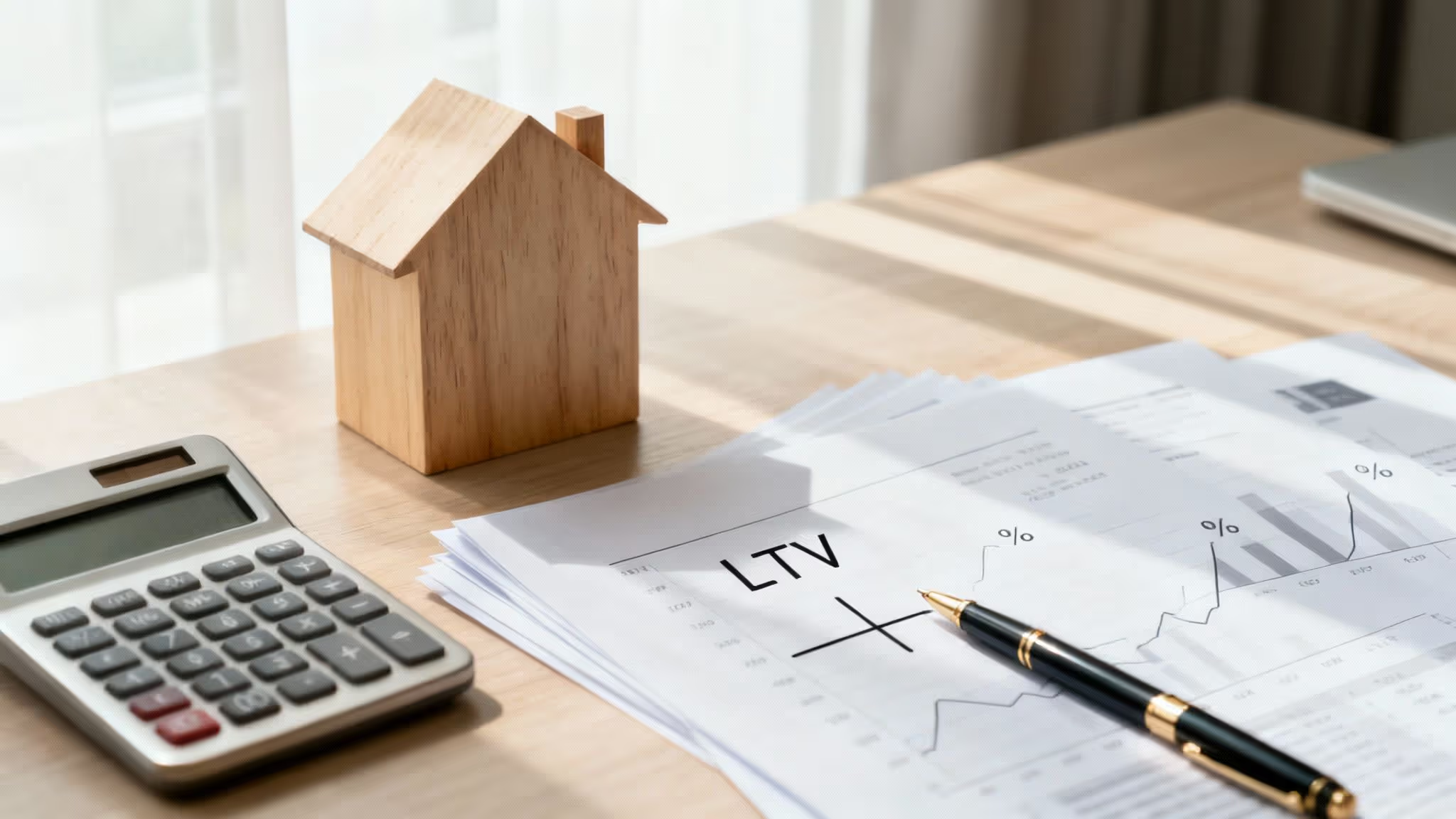Calculating your Loan-to-Value (LTV) is refreshingly simple: just divide the loan amount by the asset's appraised value. That single percentage is a powerhouse metric for lenders, giving them a crystal-clear picture of their risk versus the value of your collateral.
What Is Loan to Value and Why It Matters
At its core, Loan-to-Value (LTV) is a straightforward financial ratio that compares the amount you're borrowing to the official market value of the asset you're financing. Think of it as a lender's primary risk assessment tool. When a bank lends a significant sum for a house, they need to know how much personal stake, or "skin in the game," you have.
A higher LTV ratio means you're borrowing more and putting down less, which signals a higher risk to the lender. Conversely, a lower LTV indicates you have significant equity invested, making the loan a much safer bet. This single number can influence everything from your interest rate to whether your loan is approved.
While it's a household term in real estate, understanding metrics like LTV is critical across many financial decisions—much like how to calculate return on ad spend is fundamental for marketers.
The Basic LTV Formula
The formula itself is as easy as it gets. To find the loan-to-value ratio, you divide the loan amount by the appraised value of the asset and then express it as a percentage.
Let's say a borrower wants a $400,000 loan for a property that appraises for $500,000. The calculation would be:
($400,000 ÷ $500,000) = 0.80, or 80% LTV.
This ratio is the lender’s primary tool for assessing risk. The higher that percentage climbs, the riskier they consider the loan. You can find more insights on how lenders view risk over at concreit.com.
This infographic neatly lays out the simple process for calculating your LTV.

As the visual shows, all you need are two key numbers: the total loan amount and the asset's official appraised value.
Why Lenders Focus on the 80% LTV Benchmark
The 80% LTV mark is frequently mentioned in lending, and for good reason. It’s the unofficial gold standard for a low-risk conventional mortgage.
When your LTV is at or below 80%, it signifies a solid 20% equity stake in the property from the start. Lenders see this as a serious financial commitment, which dramatically lowers the odds they’ll lose money if you default on the loan.
For borrowers, staying below the 80% LTV threshold is a huge deal. Go above it, and you'll almost certainly be required to pay for Private Mortgage Insurance (PMI)—an extra monthly cost that protects the lender, not you.
This insurance premium is added to your mortgage payment, increasing your total housing costs until your equity grows and your LTV drops back down. Knowing how to calculate LTV in advance allows you to anticipate these potential costs and structure your financing to avoid them.
LTV Risk Tiers at a Glance
The LTV ratio places borrowers into different risk categories, which directly impacts loan terms. This table provides a quick snapshot of what to expect at various LTV levels.
As you can see, a lower LTV doesn't just save you from PMI; it generally unlocks the best possible loan terms a lender has to offer. It's a clear signal to them that you're a reliable borrower with a vested interest in the property.
Calculating LTV in Different Real-World Scenarios
The basic Loan-to-Value formula is a fantastic starting point, but its real power is revealed when applied to complex, real-world financial situations. How the LTV numbers are run shifts depending on whether you're buying, refinancing, or tapping into your home's equity. Understanding these nuances is what separates a good financial decision from a great one.
A common point of confusion is the difference between a property's purchase price and its appraised value. You might agree to buy a home for $520,000, but if an independent appraiser values it at only $500,000, lenders will always use the lower number for their LTV calculation. For them, the appraised value represents the property's objective market worth.

Calculating LTV for a Home Refinance
When you refinance your mortgage, the process feels different, but the LTV calculation remains fundamentally the same. Instead of a purchase price, the key figures are your remaining mortgage balance and a new appraisal. Lenders require a current valuation to ensure the property's value still comfortably supports the loan.
Let's say your current mortgage balance is $300,000, and a fresh appraisal values your home at $450,000.
- Calculation: ($300,000 ÷ $450,000) = 0.667
- Result: Your LTV for the refinance is 66.7%.
This excellent LTV puts you in a prime position to lock in a better interest rate and, if you're still paying it, finally drop that PMI. For any homeowner looking to optimize their mortgage, this is a game-changer.
Key Takeaway: For a refinance, LTV is all about the new appraised value, not what you originally paid for the house. A big jump in home value over the years can slash your LTV and open up much more favorable loan options.
Factoring in a HELOC with Combined LTV
Things get more complex when you add a second loan, like a Home Equity Line of Credit (HELOC). In this case, lenders look at the Combined Loan-to-Value (CLTV) to get a full picture of their total risk. CLTV simply accounts for all loans secured by your property.
To find your CLTV, you add the balance of your main mortgage to the amount of the new loan or line of credit, then divide that total by the home's appraised value. Understanding this metric is as crucial for a homeowner as a solid real estate SEO guide to improve search visibility is for an agency's growth.
Here’s a clear example:
- Appraised Home Value: $500,000
- Current Mortgage Balance: $350,000
- Desired HELOC Amount: $50,000
First, add the two loan amounts together: $350,000 (mortgage) + $50,000 (HELOC) = $400,000 in total debt.
Next, divide this total by your home's value:
- Calculation: ($400,000 ÷ $500,000) = 0.80
- Result: Your CLTV would be 80%.
Most lenders draw the line around an 85% CLTV. By running these numbers yourself beforehand, you can determine how much equity you can realistically access without being denied. It’s a proactive step that eliminates surprises and puts you in control when managing your home equity.
The Financial Impact of Your LTV Ratio
Your Loan-to-Value (LTV) ratio is more than just technical jargon; it's a number with a direct line to your wallet. A lower LTV is your single greatest negotiating tool—it unlocks better interest rates, more flexible terms, and noticeably lower monthly payments. Simply put, a low LTV tells lenders you're a lower-risk borrower, and they will reward you for it.
For seasoned investors, mastering LTV is fundamental. They often leverage a strong LTV position to pull equity from one property via a cash-out refinance, then use that cash for the down payment on another. It's a classic strategy for scaling a real estate portfolio.

Unlocking Better Loan Terms
A low LTV does more than just shave a few dollars off your payment; it can completely change the structure of your loan. When lenders see you have significant skin in the game, they become much more willing to offer flexible, favorable terms.
This can mean:
- Lower Interest Rates: Even a fraction of a percentage point saved on interest can accumulate into tens of thousands of dollars over the life of a 30-year mortgage.
- Avoiding PMI: As noted, crossing the 80% LTV threshold triggers Private Mortgage Insurance. A lower LTV eliminates this extra monthly cost entirely.
- Easier Qualification: Borrowers with a strong LTV often find the approval process is smoother and far less of a headache.
The connection between LTV and your financial outcome is analogous to business performance. Just as a smart business owner is obsessed with evaluating ROI in digital marketing to ensure profitability, a savvy borrower should view a lower LTV as a direct path to improving their property's financial return.
A strong LTV ratio is not just about getting a loan approved. It’s about securing the best possible loan—one that minimizes your costs and maximizes your financial flexibility for years to come.
The Staggering Cost of High LTV
To illustrate the financial impact, let's compare two scenarios for a borrower taking out a loan on a $500,000 home. The long-term difference in cost is eye-opening.
The following table breaks down how seemingly small differences in LTV can lead to massive savings over the lifetime of a mortgage.
The numbers don't lie. The borrower in Scenario B saves over $100,000 in interest alone, not including the thousands avoided in PMI payments. This makes it crystal clear: actively managing and improving your LTV is a critical financial skill that pays huge dividends.
How LTV Shapes Broader Economic Health
While your individual Loan-to-Value (LTV) ratio feels intensely personal, it’s a single data point in a much larger economic landscape. Economists and policymakers don’t look at one loan to check the pulse of the housing market; they analyze the combined LTV data of millions.
This bird's-eye view reveals crucial trends in consumer debt, market stability, and overall economic risk. Your personal LTV, when aggregated across an entire population, becomes a powerful indicator of the market's health. A widespread trend of low LTVs suggests a stable market where homeowners have significant equity. Conversely, a surge in high-LTV loans can be an early warning sign of a housing bubble, signaling that too much debt is being extended against potentially inflated asset values.
This is precisely why LTV regulations exist. They aren't arbitrary hurdles for borrowers; they are essential guardrails designed to protect the entire financial system from systemic risk.
The Ripple Effect of High-Risk Lending
We only need to look back at past financial crises for a clear lesson on the dangers of unchecked high-LTV lending.
When lending standards relax and high-LTV loans become common, it can create a dangerous domino effect. More buyers enter the market with less money down, artificially inflating demand and driving up property prices. This fosters an unstable environment where even a slight market downturn can leave a massive number of homeowners "underwater"—owing more on their mortgage than their home is worth.
Historically, the distribution of LTV ratios has been a critical area of study for understanding mortgage defaults. Economists have shown that in the years leading up to the 2007 financial crisis, LTV distributions shifted dramatically as more borrowers secured loans with LTVs above 90%. This practice significantly increased frontline risk within the mortgage market. You can dig deeper into these economic patterns in research from the National Bureau of Economic Research.
Understanding this context adds a new layer of meaning to your own loan application. Your ability to secure a loan with a healthy LTV contributes, in a small but meaningful way, to the stability of the entire real estate ecosystem.
This macroeconomic perspective also underscores the importance of the ongoing digital transformation in real estate. New technologies are giving us more accurate and timely ways to analyze these critical risk indicators.
LTV as a Regulatory Tool
Policymakers rely heavily on aggregate LTV data to inform their decisions. If they spot a risky trend developing, they might intervene with measures to tighten lending standards, such as increasing down payment requirements or adjusting capital requirements for banks. These actions are designed to cool an overheated market and prevent a repeat of past crises.
So, by learning how to calculate LTV for yourself, you're engaging with a metric that is fundamental not just to your personal finances but to the health of the entire national economy. It’s a number that truly operates on both a micro and macro level.
Actionable Strategies to Improve Your LTV Ratio
Knowing how to calculate your LTV is just the first step. The real power comes from taking control of that number. If your Loan-to-Value ratio is higher than you'd like, there are several effective strategies you can use to bring it down. Improving your LTV puts you in a much stronger financial position, opening the door to better loan terms and significant long-term savings.

These are not abstract concepts but practical, actionable steps you can start working on today to directly influence your borrowing power. Each tactic tackles a different part of the LTV equation, giving you flexibility in how you approach your financial goals.
Boost Your Down Payment
The most direct way to lower your LTV from day one is to increase your down payment. A larger initial investment shrinks the amount you need to borrow—the "loan" portion of the Loan-to-Value ratio. This single move can be the difference between paying for Private Mortgage Insurance (PMI) and avoiding it completely.
Mini Case Study: Imagine you're buying a $500,000 home. A 15% down payment ($75,000) means you need a loan of $425,000, resulting in an 85% LTV. By saving an additional $25,000 for a 20% down payment ($100,000), your loan drops to $400,000. Instantly, your LTV hits the ideal 80% mark, and you've saved yourself from PMI payments.
Pay Down Your Principal Strategically
If you already have a mortgage and plan to refinance, you can lower your LTV by making extra payments toward your loan's principal. Even small, consistent payments can make a surprising dent in your loan balance over time.
For a more immediate impact, a larger, lump-sum payment before applying for a new loan can be highly effective. This is especially useful if you’ve recently received a bonus, inheritance, or other windfall. Applying it directly to your mortgage principal is a guaranteed way to reduce your debt and boost your equity before the new appraisal.
Increase Your Property's Appraised Value
The other side of the LTV equation is the "value" component. Strategic home improvements can increase your property’s appraised value, which lowers your LTV ratio without you having to pay extra toward the loan.
The key is to focus on projects with a high return on investment, such as:
- Kitchen or Bathroom Remodels: These are consistently cited as adding the most value.
- Adding Square Footage: A new bedroom or a finished basement can significantly boost your home's worth.
- Improving Curb Appeal: First impressions matter. Upgraded landscaping and a fresh exterior can make a real difference to an appraiser.
A higher appraisal means your existing loan balance represents a smaller percentage of the home's total worth, which directly improves your LTV.
Data from the Federal Reserve shows that the median original LTV for U.S. mortgages often hovers around 80%, reflecting that common sweet spot between down payments and financing. You can dig into more mortgage data trends on the official FRED website.
While this section has focused on real estate LTV, the core concept of improving value is universal. For a business perspective, check out our guide on increasing customer lifetime value.
Got Questions About LTV? Let's Clear Them Up.
As we conclude, it's common for specific questions to arise. The real world of finance is rarely as clean as a simple formula, so let's address some of the most frequent situations you might encounter. This will help iron out any final details so you can move forward with confidence.
Does My Loan Type Affect The Maximum Allowable LTV?
Absolutely. Different loan programs are designed for different financial scenarios, and each has its own LTV limits. This is crucial to understand when shopping for a mortgage.
- Conventional Loans: These typically max out at a 97% LTV. However, any conventional loan with an LTV over 80% almost always requires Private Mortgage Insurance (PMI).
- Government-Backed Loans: These loans are often more flexible. An FHA loan, for example, allows an LTV up to 96.5%. For those who qualify, VA and USDA loans can go all the way to 100% LTV, enabling a home purchase with no down payment.
Knowing these limits from the outset helps you focus on the loan options that best fit your financial picture.
What Is CLTV and When Does It Matter?
CLTV, or Combined Loan-to-Value, becomes the key metric the moment you have more than one loan on a property. A classic example is having a primary mortgage plus a Home Equity Line of Credit (HELOC).
Lenders use CLTV to gauge their total risk exposure. They calculate it by adding all loan balances together and dividing that total by the property's appraised value. When you apply for a second loan, the new lender makes their decision based on your CLTV, not just your first mortgage's LTV.
Can I Challenge a Low Appraisal to Improve My LTV?
Yes, you can, but you must be prepared. If an appraisal comes in lower than expected and negatively impacts your LTV, you have the right to request a "Reconsideration of Value."
To have a real shot, you need to bring solid proof that the appraiser's valuation was off. This isn't about what you feel the house is worth; it's about facts. You'll need things like recent, more relevant comparable sales (comps) the appraiser might have missed, or pointing out factual errors in the report itself, like an incorrect square footage count.
A successful challenge can directly increase the appraised value. That, in turn, lowers your LTV ratio, potentially opening up much better loan options and terms for you.
Figuring out the complexities of business growth means getting a real handle on key metrics like LTV. Here at Twelverays, we live and breathe data-driven strategies that turn insights into real, measurable results—from fine-tuning customer acquisition to setting up powerful CRM solutions. See how our award-winning digital marketing services can help you achieve a lasting impact.





